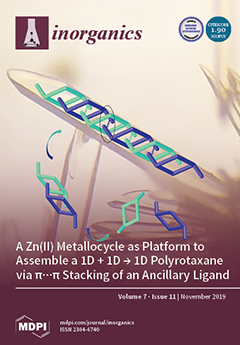The novel phosphanylalumanes, Al–P single-bond species, fully bearing carbon protecting groups on aluminum and phosphorus atoms, are synthesized by the reactions of aluminum monohalides [(
t-Bu)
2AlBr and (C
6F
5)
2AlCl·0.5(toluene)] with Mes
2PLi. Regarding the
[...] Read more.
The novel phosphanylalumanes, Al–P single-bond species, fully bearing carbon protecting groups on aluminum and phosphorus atoms, are synthesized by the reactions of aluminum monohalides [(
t-Bu)
2AlBr and (C
6F
5)
2AlCl·0.5(toluene)] with Mes
2PLi. Regarding the
t-Bu system, λ
3,λ
3-phosphanylalumane is obtained. Concerning the C
6F
5 system, on the other hand, the corresponding LiCl complex, λ
4,λ
4-phosphanylalumane, is obtained. The Al–P bond lengths of C
6F
5-substituted λ
3,λ
4-, and λ
4,λ
4-derivatives are much shorter than those of the reported λ
3,λ
4-phosphanylalumane derivatives and comparable to that observed for the previously reported λ
3,λ
3-phosphanylalumanes. Theoretical calculations reveal that the binding of the C
6F
5 groups to Al results in a large contribution of Al and a large
s-character in the Al–P bond of phosphanylalumanes. Considering
t-Bu-substituted phosphanylalumanes, the Al–P bond lengths reflect the coordination number of Al, showing a longer Al–P bond length in the case of λ
4-Al as compared with that of λ
3-Al. Combining the structural, spectroscopic, and theoretical results, the
t-Bu-substituted λ
3,λ
3-phosphanylalumane has well separated vacant p orbital and lone pairs, which is suitable for reactivity studies.
Full article





